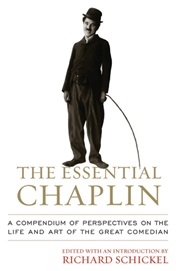(Ivan R. Dee Publishers, 315 pages, $27.55)
Edited and with an introduction by Richard Schickel
 Year by year, Chaplin, the first superstar of the 20th century, fades into history. It’s been 117 years since his birth, nearly 30 since his death. The vaudeville that molded him is gone. So are the lumpen audiences of the nickelodeons. The first movie to feature his Little Tramp, Kid Auto Races at Venice, was made nine months before World War I. The silent cinema that enabled him to “speak” to a polyglot audience is a memory, as is the heyday of Hollywood that he helped establish.
Year by year, Chaplin, the first superstar of the 20th century, fades into history. It’s been 117 years since his birth, nearly 30 since his death. The vaudeville that molded him is gone. So are the lumpen audiences of the nickelodeons. The first movie to feature his Little Tramp, Kid Auto Races at Venice, was made nine months before World War I. The silent cinema that enabled him to “speak” to a polyglot audience is a memory, as is the heyday of Hollywood that he helped establish.
And yet, he remains universal and still speaks to us as directly today as ever. Just ask any 6-year-old who’s just seen The Kid for the first time. For those eager to reacquaint themselves with the seminal cinematic figure of the first half of the 20th century without tackling one of his many heavy biographies (David Robinson’s Chaplin: His Life and Art remains the benchmark), Richard Schickel’s excellent selection of critical and biographical essays is a fine place to begin. He has assembled some of the best writing from our own contemporaries (Andrew Sarris, Gilbert Adair, J. Hoberman) as well as Chaplin’s (Edmund Wilson, Robert Warshow, even Winston Churchill). He gives equal space to blistering dissenters like David Thomson and overenthusiastic defenders like James Agee (his three-part defense of Monsieur Verdoux from The Nation is overdoing it). Freshest of all is Schickel’s profoundly insightful 40-page introduction, generous and caustic by turns, well-balanced and alive to what is great about Chaplin, as well as to his flaws.
Review written by John Patterson.